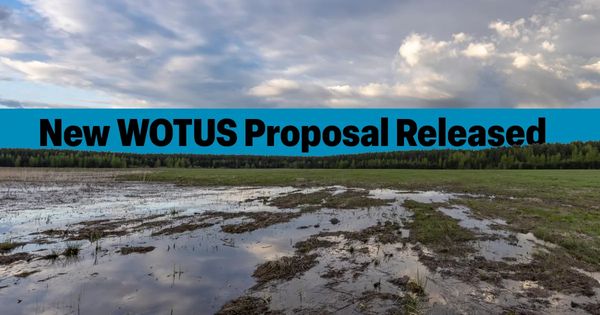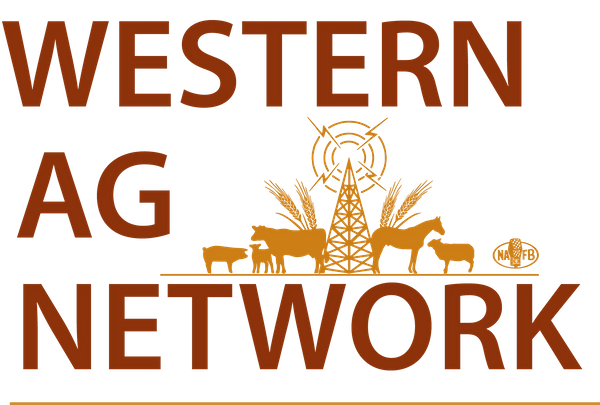.png?fit=outside&w=1200&h=630)
New WOTUS Proposal Released
November 17, 2025
The Trump administration on Monday rolled out a new proposal to redefine Waters of the United States (WOTUS), aiming to align federal water regulations with the U.S. Supreme Court’s ruling in Sackett v. EPA and answer long-standing calls from farmers, ranchers, and landowners for regulatory certainty.
The announcement follows nine public listening sessions held across the country during the past year, where agricultural producers urged the Environmental Protection Agency (EPA) to simplify the WOTUS definition and eliminate confusion created by multiple rule changes under the Obama and Biden administrations.
Agriculture groups were quick to applaud the Trump Administration's new WOTUS rule. This week the Montana Farm Bureau is hosting it's annual convention in Missoula and MFBF Governmental Affairs Senior Director Nicole Rolf shared with the Western Ag Network their optimism regarding this important topic.
Key Changes in the Proposed Rule
In its proposal, the EPA seeks to clearly define terms such as “relatively permanent,” “continuous surface connection,” and “tributary,” tightening the scope of federal jurisdiction under the Clean Water Act. Highlights include:
- Jurisdictional tributaries must directly connect—or connect through consistently flowing features—to traditionally navigable waters.
- Wetlands would only fall under federal control if they are indistinguishable from jurisdictional waters through a continuous surface connection.
- Ephemeral and most intermittent waters—including prairie potholes and ditches that only carry water after storms—would not be regulated.
- Groundwater, certain ditches, prior converted cropland, and waste treatment systems remain excluded from federal oversight.
- New reliance on familiar terms like “wet season” to determine when water features qualify as WOTUS.
EPA Administrator Lee Zeldin emphasized the agency’s goal to create a lasting, common-sense definition that landowners can understand without legal assistance.
“Across the country, news of today’s proposal is going to be met with a lot of relief and happiness from farmers, ranchers, and landowners,” Zeldin said. “This wasn’t about swinging a political pendulum. It’s about getting it right.”
Once published in the Federal Register, the proposal will undergo a 45-day public comment period, with two public meetings planned as EPA works “expeditiously” to finalize the rule.
Agriculture Groups Applaud the Proposal
Agricultural organizations—long frustrated by shifting federal interpretations of WOTUS—offered swift support for the new rule.
The National Cattlemen’s Beef Association (NCBA) praised the EPA for removing burdensome regulations that previously swept small, isolated features into federal jurisdiction.
“WOTUS has been a longstanding and frustrating issue for family farmers and ranchers,” said NCBA President and Nebraska cattleman Buck Wehrbein. “We appreciate the EPA finally fixing previous WOTUS rules and supporting America’s family farmers and ranchers.”
NCBA leaders noted that past rules under the Obama and Biden administrations often treated prairie potholes, playa lakes, and dry ditches as if they were major navigable waters. The association has spent years advocating on Capitol Hill and in court—including filing an amicus brief in the Sackett case—to limit federal authority.
Since the Trump administration took office in early 2025, NCBA says it has worked directly with new EPA leadership to craft a rule that ends the uncertainty producers have faced for more than a decade.
“Today’s announcement acknowledges that the federal government should protect lakes, rivers, and oceans—not regulate ditches and ponds on family farms,” said NCBA Chief Counsel Mary-Thomas Hart.
NCBA and state affiliates plan to submit formal comments during the public review period.
Environmental Groups Warn of Harm to Water Quality
Environmental advocates sharply criticized the EPA’s proposal, arguing it would remove long-standing protections for wetlands and small streams that safeguard water quality and reduce flooding.
Jim Murphy, senior director of legal advocacy for the National Wildlife Federation, warned the rule would “strip protection from streams that flow into the rivers and lakes that supply our drinking water.”
“This rule will increase the risk of elevated nitrates and cyanotoxins in drinking water, harming our health,” Murphy said, adding that weakened protections could raise treatment and insurance costs for families.
The Chesapeake Bay Foundation echoed those concerns, arguing that excluding isolated wetlands and seasonal streams will undermine ongoing restoration efforts.
“Wetlands…provide habitat for fish and wildlife and protect communities from extreme weather,” said Keisha Sedlacek, the foundation’s senior policy director. “This proposal would deal a serious blow to the Chesapeake Bay.”
Looking Ahead
The EPA says the proposed rule reflects the Supreme Court’s decisions in both Sackett and Rapanos, focusing federal oversight on relatively permanent waters and wetlands that directly touch navigable waters.
As the public comment period approaches, the agency will continue gathering input from both supporters and critics. EPA leaders insist the final rule will aim to provide clarity and consistency—while agricultural, environmental, and legal communities prepare for another pivotal round in the long-running WOTUS debate.
Source: DTN, Western Ag Network










